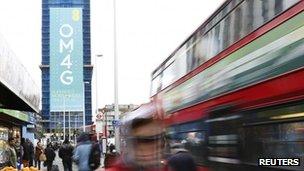Ofcom names 4G auction bidders
- Published

The results of the 4G auction will be known in February and March
Seven bidders for the auction of bandwidth for 4G mobile broadband services have been named by Ofcom.
The bidders are Everything Everywhere, BT, Vodafone, O2 and Three, as well as Hong Kong conglomerate PCCW and UK network supplier MLL Telecom.
The telecoms regulator said, external the auction would increase the amount of airwave available for mobiles by more than 75%.
The auction is due to start next month, with licences granted by March and services launching in May and June.
The complete list of bidders is:
Everything Everywhere (EE), which has already been permitted to launch the UK's first 4G service using existing bandwidth and did so on 30 October
PCCW, a major Hong Kong telecoms conglomerate, operating through its subsidiary HKT
Hutchison Whampoa, another Hong Kong conglomerate and operator of the 3 network
MLL Telecom, a telecom network supplier founded in 1992 and based in Marlow, Buckinghamshire
BT, via its subsidiary "Niche Spectrum Ventures"
Telefonica, the Spanish incumbent telecoms company that owns the O2 network
Vodafone
"New 4G services will stimulate investment, growth and innovation in the UK, and deliver significant benefits to consumers in terms of better, faster and more reliable mobile broadband connections," said Ed Richards, Ofcom's chief executive.
Download speeds will initially be at least five to seven times faster than existing 3G networks, Ofcom claimed.
Ofcom aims to award licences to at least four "credible national wholesalers of mobile services".
The auction is expected to raise £3.5bn for government coffers, or 0.2% of the UK's annual economic output, according to the Office for Budget Responsibility - far less than the £22bn raised by the auction of 3G space, which was held at the height of the dotcom bubble in 2000.
However, many analysts are sceptical that the 4G auction will raise even £3.5bn.
Penetrating buildings
The auction is making use of the 800MHz radio spectrum freed up by the switch from analogue to digital television, and also offers an additional higher-frequency 2.6GHz band.
Ultra-high frequencies - between 300MHz and 3GHz - are seen as a sweet-spot for mobile communications, as they combine acceptable signal range with adequate capacity for high data transmission, such as in the case of video streaming.
Lower frequency radio waves travel further and penetrate buildings more easily, and are seen as better suited to rural areas.
The higher frequency band is better able to cope with heavy data transmission, and is seen as preferable in urban areas, although its more restricted reception area means that operators may need to set up more masts, including inside some public buildings.
EE, which was formed from the merger of Orange and T-Mobile in the UK, is said to be taking part so that it can gain additional frequency bands to expand its recently launched 4G service.
EE has made use of old 2G - non-broadband - 1.8GHz bandwidth, that the merged network inherited from its two predecessors, after being given a special dispensation from Ofcom in August.
However, the network has been criticised for being patchy and unreliable.
One test conducted in Manchester found that just 40% of tested locations got 4G reception from EE. The 4G provider, however, said the test was conducted in Greater Manchester and the service is available in over 80% in the city itself.
Spare capacity?
More 4G capacity will become available in the coming years.
Earlier this week, the Ministry of Defence said that it would also auction off even higher frequency bandwidth - up to 15GHz - that it owns, but not until 2014.
Meanwhile, a ruling by the European Union requires Ofcom to permit operators to switch existing 3G bandwidth they currently control over to 4G from 2014.
The additional bandwidth is useful to operators, as individual 4G services take up a bigger chunk of spectrum than earlier mobile telephony, although 4G is also more versatile in the range of bandwidths that it can operate within.
Mobile services occupy relatively tight bands of the radio spectrum within the 300MHz to 3GHz sweet-spot, meaning that there is plenty of capacity available to support much greater mobile data transmission in future.
However, Ofcom's ability to provide new bandwidths within the UK is limited by the need to harmonise bandwidths internationally.
Mobile handsets are designed to tune into the same specific frequencies in many different countries. Producing a separate handset just for UK-only frequencies would be more expensive for manufacturers.
The new 800MHz frequency for 4G is being made available across the whole of Europe as a result of the switch-off of analogue television broadcasting.
Ironically, the UK was the first country to inaugurate digital television in 2007, but then had to change the frequency of digital TV broadcasting - requiring people to retune their television - in order to bring the UK into line with the rest of Europe.
- Published31 October 2012
- Published17 December 2012
- Published12 December 2012
- Published5 December 2012
- Published20 November 2012